When growing onions from seed there are a few things you need to consider before putting those seeds in the ground, or in this case, starting them indoors. Keep reading to find out how I start my onions, and how I stray from seed package recommendations for better results.
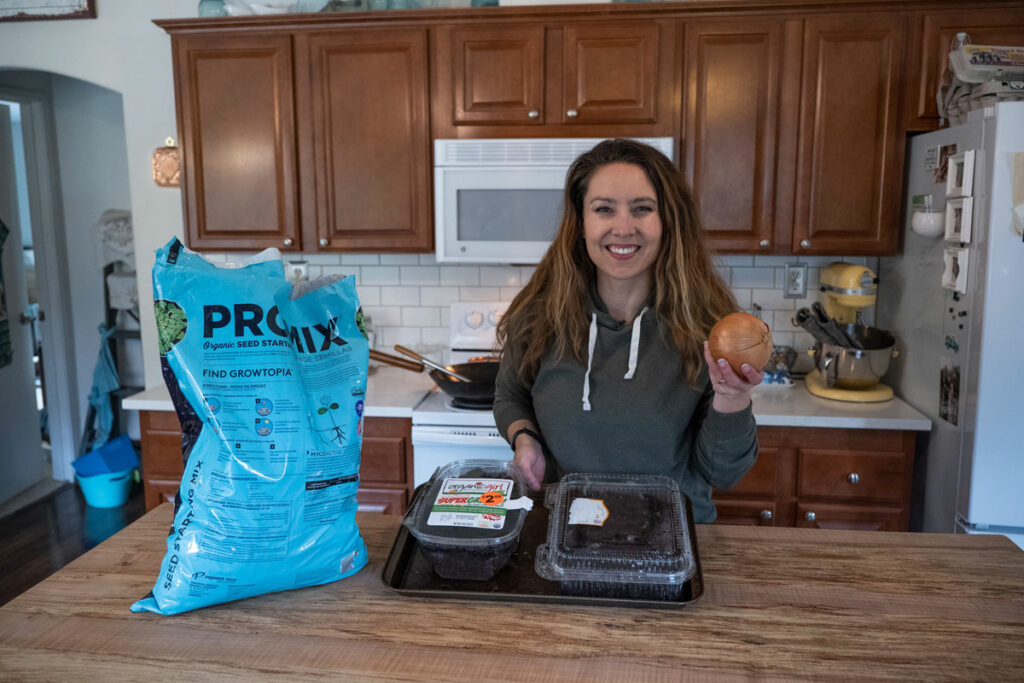
I talk a lot about growing enough food to feed your family for a year. In fact, I wrote an entire book dedicated to the topic. You can check out My Family Garden Plan and My Family Garden Planner for more information, and you can also check out my blog post and podcast for a quick summary of how much to plant per person for a year’s worth of food.
Growing onions has become second nature in my garden. They’re generally very low-maintenance once planted and, if you choose the right varieties, can store for up to 12 months. Check out how to harvest, cure, string, and store onions.
When we talk about growing enough food for the year, it’s important to think about the varieties you’re planting to make sure they’re good storage varieties.
Types of Onions
When you’re growing onions, especially if you want to grow enough for an entire year, it’s important to choose the right type of onion for your growing zone.
You also want to be sure, within those types of onions that you’re growing varieties that are good for storage. It’s fine to grow onions that aren’t good for long-term storage, but you’ll need to be sure to use those onions first.
- Long-Day
- Neutral-Day
- Short-Day
Onion Varieties I’m Growing
- Patterson – a yellow storage onion
- Red Wing – red onion (supposed to be a good storage variety)
- Newberg – yellow onion, new to me this year, grown in my region
- Copra – yellow onion, grows well in northern regions
- Blush – I’ve only found sets for the blush onions, but they’ve also done really well for us in previous years.
Subscribe to Melissa K. Norris!
Get updates on the latest posts and more from Melissa K. Norris straight to your inbox.
We use your personal data for interest-based advertising, as outlined in our Privacy Notice.
Pelleted Seeds or Regular Seeds?
I’ve tried both the pelleted seeds and seed packets in the past and have found that the loose seeds tend to germinate much faster than the pelleted variety.
In fact, last year my seeds had germinated by day 4 and the pelleted seeds didn’t germinate until day 14.
There’s nothing inherently wrong with the pellets, but you’ll pay more for them per seed and they take longer, so for me, I choose the packet of loose seeds.

How to Grow Onions From Seed
Onions tend to have a lower germination rate than many other vegetables that you may be seed starting indoors, so when starting onions you may want to over sow, just in case some of your seeds don’t sprout.
This is how I start my onions indoors to plant in early spring.
Use Sterile Soil
Using sterile soil seems backward when we’re usually working toward having a good variety of microorganisms, but when it comes to starting seeds having sterile soil is good for a few reasons:
- No pathogens from the garden so we don’t have to deal with bacterial or fungal disease like wilt or dampening-off disease. These can affect your baby seedlings when grown indoors.
- No bugs from the soil where bugs have laid their eggs – having gnats in the house is such an annoying thing to deal with when starting seeds indoors.
Choose a Container
When it comes to growing onions, you’re going to need a container that’s a bit deeper than needed for other vegetables so you can get a good bulb formation.
I like to repurpose the plastic clamshell containers that you buy lettuce in at the grocery store. These make a great greenhouse while the seeds are sprouting and are deep enough that I won’t need to pot up my onions before it’s time to plant them in the garden (which isn’t recommended anyway).
Plant Seeds
Using your finger, drag it across the soil in a line about 1/4 inch deep and 1 inch apart. Densely sow your onion seeds (you can always thin them out later) and cover them with just a sprinkling of soil.
Water
Using a spray bottle, or gently watering so the seeds don’t get moved around, water your soil until it’s damp, not sopping or pooling, but to where all the soil is damp.
It’s important during the germination phase to never let the top of the soil dry out, so check it throughout the day and be sure you’re keeping those seeds damp.
I like using the clamshell containers because during this time the seeds don’t require a grow light, so I can tuck the containers over by my woodstove where they’re out of the way, but not out of sight (because we all know what happens when something is out of sight!).
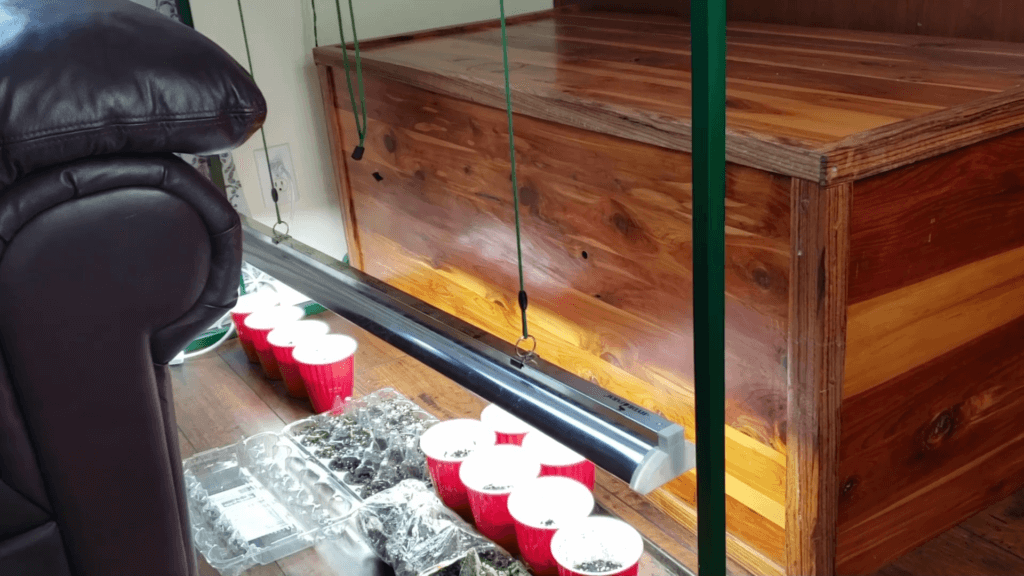
Grow Light
Once the seeds have germinated (or sprouted), move them under a grow light. The onions will begin to grow taller and look like tiny green onions.
When the onion tops grow to about 6-8 inches tall trim them down with scissors to about 4 inches. As they continue growing, continue trimming them. You can eat the trimmings just as you would green onions.
Transplanting Onions Into the Garden
When it’s time to transplant your onions into the garden you’ll need to harden them off to get them prepared for the colder temperatures.
Onion sets can be planted out about 4-6 weeks before your last frost date. I like to start mine indoors about 16 weeks before the last frost date, which is generally in April here in the Pacific Northwest.
This allows the bulbs to get about as big as the bulbs on onion sets that I buy, so I like to have this extra bit of growing time.
To learn more about what’s happening in my garden in April, check out Gardening in April (Tasks by Month).
Direct-Sowing Onions
If you’d like to skip starting onions indoors, you can direct sow onion seeds once the soil temperature is 35 degrees F. They’ll take longer to grow than planting onion sets (which is what we’ve grown indoors), and your harvest may be closer to a fall harvest rather than an early to mid-summer harvest.
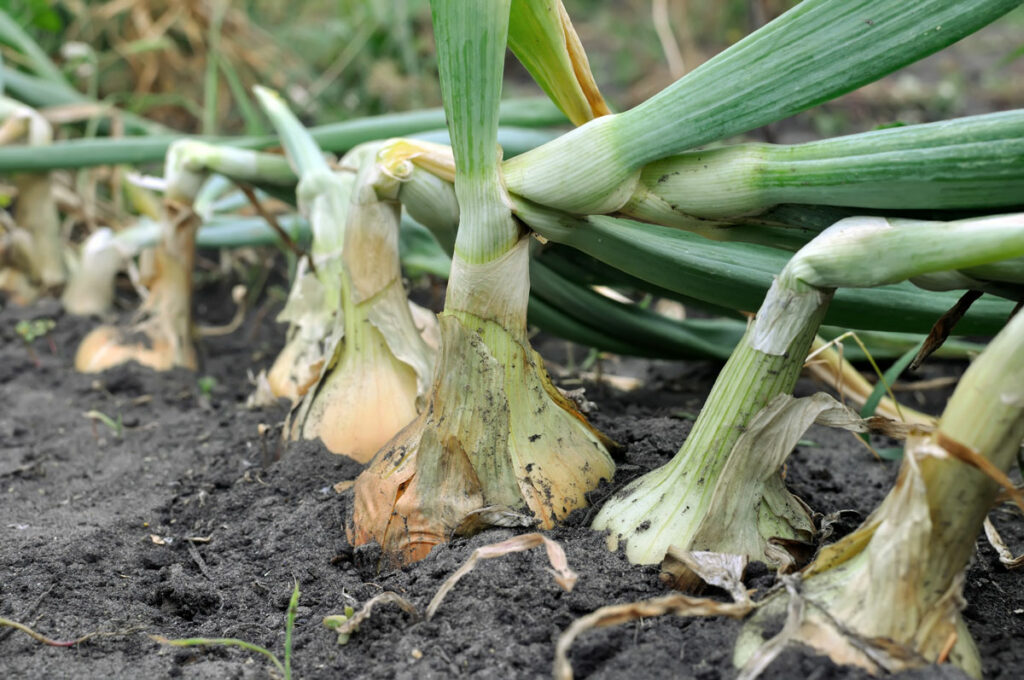
More Posts You May Enjoy
- How to Know When Onions are Ready To Harvest
- Curing and Storing Onions
- How Much to Plant Per Person
- How to Plant and Grow Potatoes (In Containers or the Ground)
- How to Grow Mushrooms at Home
- How to Plant Garlic (Fall Garlic Planting)
- How to Grow Tomatoes
- How to Plant Strawberries- 5 Tips to Success
- How to Grow (and When to Pick) Pole Beans
- How to Grow Swiss Chard in your Fall Garden
- How to Grow and Plant Beets
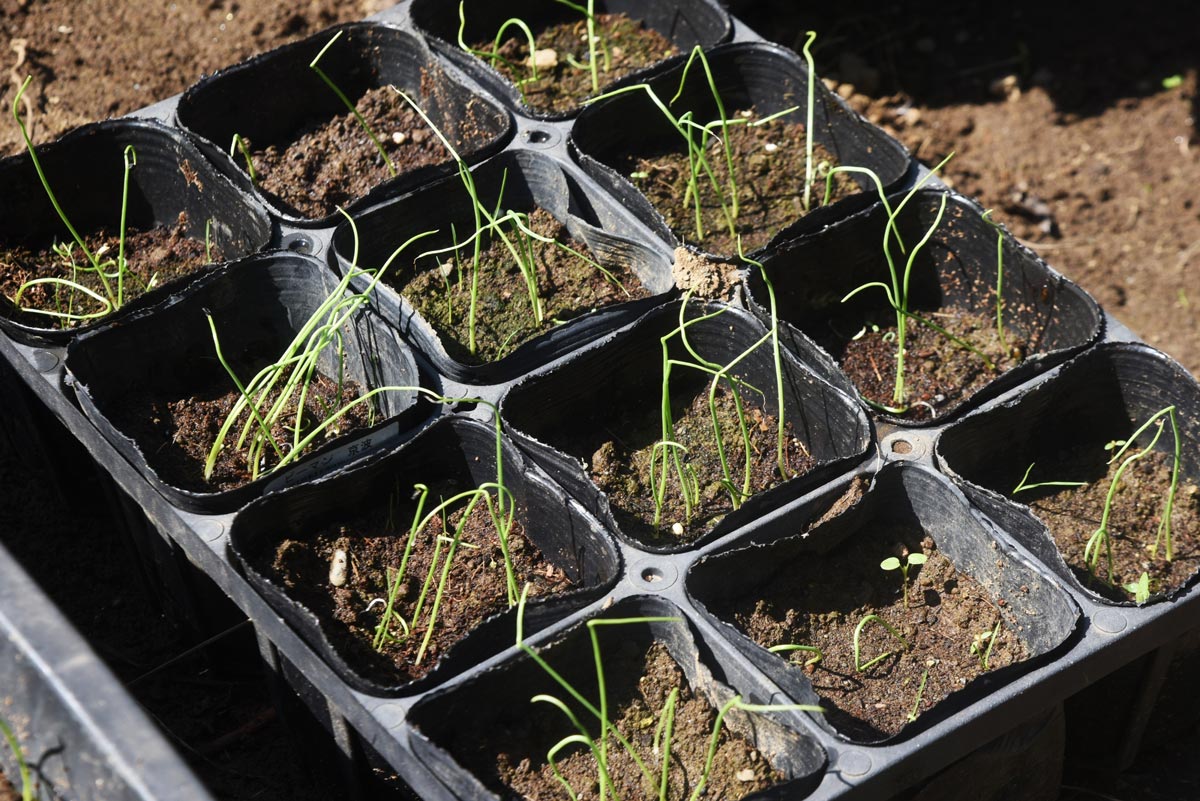
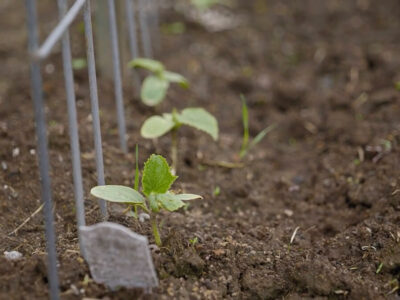

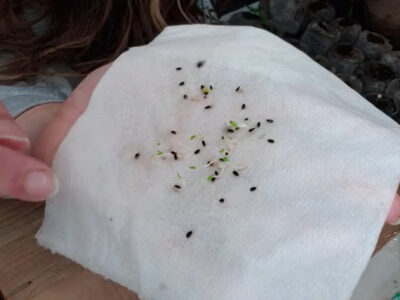
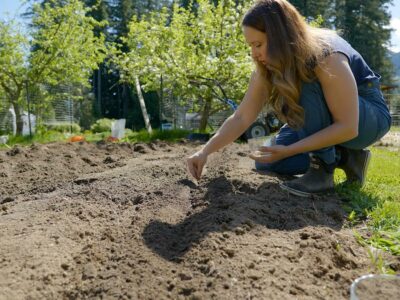






I have onions growing now some from purchased starts and some from seed. They seem to be taking a long time to form a bulb? Is there such thing as a gardener doing something wrong that makes the onion not bulb or do I just need to be patient? And is there something I need to do to feed them while they grow? Thanks for the help.
You probably have an answer by now but onions won’t bob out until they mature and until you reach the number of hours of daylight appropriate for that variety of onion. They will either be a long, neutral or short day onion and they won’t bulb out fully until you get over 14 hours of sunlight for long day, over 12 hours for neutral or intermediate, or over 10 hours for short day.
hello my names suzie
can you tell how to grow veg in the greenhoues
Hello, I bought onion seeds and want to eventually seeds save. I know that onoins are a biannual, so I know it wont flower until year 2.
I am confused on how you seed save onions.. If the onion doesn’t flower, you don’t get seeds, if I don’t get seeds to plant for next year, I cant grow those onions again. I would have to buy new seeds, which means starting from year 1 again.
What step am i missing to be able to seed save biannual crops like onions?
thank you
Brenda
Leave a couple in the ground and they will flower and give you seeds.
Hi Melissa! I have started onions from seed for the first time this year, per your tutorials and tips. 🙂 I have my red onions in a smaller clam-shell container, they are pretty crowded and small, should I thin them?
My white onions in a larger lettuce container and are looking great, even seeds from a packet over a year old came up!
Thank you for all your gardening and homesteading resources, you have been an inspiration.
Hi Mellissa: Just found you on Rumble. Welcome. I have been following you for many years and it excites me you are on this platform.Have a great gardening season.
Where do you find your Patterson Onion Seeds? I am only finding Hybrid versions
Because I’m living in the PNW, I’m trying to figure out how to keep the onions from drowning. Any suggestions?
Territorial seed company has Patterson onion seeds if anyone is looking for them.
How long do you leave grow lights on each day? Is it different for short day or long day onions? Thank you!
Grow lights don’t put off the same amount of light as the sun hour per hour so 12 hours is a minimum for starts with a grow light.
When doing the onion seed starting, do you poke holes in the bottom of the clam shell lettuce/doughnut containers for drainage? Thanks! -Jen-
yes, you always want to cut holes in the bottom of containers when planting anything in them. This will keep them from rotting and drowning.
No, I don’t. I use a spray bottle and watering can make sure I don’t over saturate the soil. If you watch your watering you don’t have to holes (in 10+ years of seed starting I’ve never poked holes and never lost a plant).